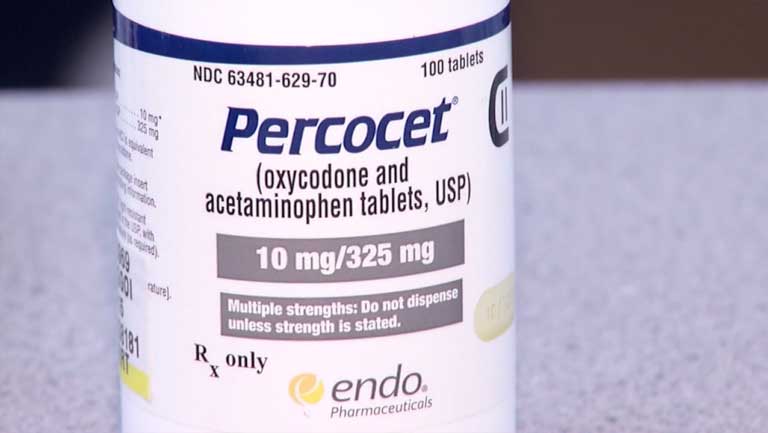Percocet Dosage | Proper Use, Abuse Potential, & Side Effects

Medically Reviewed By: Manish Mishra, MBBS
Percocet consists of the opioid oxycodone and the analgesic acetaminophen. It’s used for pain management, and your doctor may prescribe a specific dosage based on your current level of pain. Unfortunately, Percocet is also habit-forming and can be highly addictive.

Percocet is the brand name for the combination of oxycodone and acetaminophen and is an opioid prescription drug and central nervous system depressant. It’s used to relieve severe pain that didn’t respond to other types of pain medication.
Although acetaminophen isn’t habit-forming when taken over a long period of time, abusing oxycodone may increase the risk of addiction.
Percocet Dosage
The proper dosage of Percocet differs from person to person. Whatever your healthcare provider prescribes is what you should take. That said, there are average dosages for certain pain levels.
For moderate to severe pain, Percocet dosage for adults includes:
- one 2.5 mg/325 mg (dose of oxycodone/dose of acetaminophen) capsule every 6 hours as needed
- one 5 mg/325 mg tablet every 6 hours as needed
- one 7.5/500 mg tablet every 6 hours as needed
- one 10 mg/650 mg tablet every 6 hours as needed
- two 7.5 mg/325 mg extended-release tablets every 12 hours as needed
- 5 ml of 5mg/325 mg solution every 6 hours as needed
Children are sometimes prescribed Percocet but the dosage of the opioid medication must be determined by their doctor.
For chronic pain, the dose is likely scheduled to be given around the clock.
Proper Use Of Percocet
The proper use of Percocet is as a pain reliever for moderate to severe pain. Since it contains the opioid oxycodone, it is also considered a narcotic analgesic. More specifically, oxycodone binds itself to the opiate receptors in the brain and works to change how the brain perceives pain.
Acetaminophen inhibits the chemicals related to pain in the brain. It also acts on the hypothalamus region of the brain to reduce fever.
Taking your prescribed amount of Percocet, as prescribed by your doctor or healthcare provider, is considered proper use. Taking more than your prescribed dosage is a likely form of drug abuse.
Abuse Potential Of Percocet
The FDA classifies Percocet as a Schedule II controlled substance. This means that while the drug has a legitimate medical use (pain relief), it also has a high potential for abuse and can lead to psychological and physical dependence and addiction.
Percocet abuse occurs when you:
- take higher doses than prescribed
- use Percocet in a manner other than prescribed, such as crushing and snorting the drug
- mix Percocet with other drugs or alcohol
- use Percocet more frequently than prescribed
- obtain Percocet without a prescription
Abusing Percocet, or frequently taking high doses of the drug, can increase the side effects of the drug as well as the risk of addiction.
Side Effects Of Percocet Abuse
Percocet can lead to a number of side effects. The higher the dose or the more you abuse the drug, the more intense the side effects can be. Some of the most common adverse effects of Percocet may include:
- dry mouth
- stomach pain
- constipation
- drowsiness
- headache
- mood changes
Some of the rarer but more serious side effects of Percocet can include:
- changes in heart rate
- hallucinations
- fever
- severe muscle stiffness
- loss of coordination
- nausea and vomiting
- dizziness
- chest pain
- hives
- swelling of throat, tongue, lips, eyes, hands, ankles, and feet
- difficulty breathing
- seizures
- extreme drowsiness
Percocet Overdose
Abusing Percocet or taking it in higher doses, in general, can lead to an increased risk of Percocet overdose. Some of the signs and symptoms of an opioid overdose may include:
- pinpoint pupils
- lightheadedness
- low blood pressure/hypotension
- weak pulse
- sedation
- coma
- drowsiness
- respiratory depression
- bluish fingernails and lips
If you or a loved one is experiencing any of these signs or symptoms, call 911 immediately to receive emergency medical help. Additionally, if you are trained in administering naloxone (Narcan), now is the time to do that. It can reverse the effects of life-threatening overdose.
In Ohio alone, 415 people died of an unintentional opioid overdose in 2020.
Drug Interactions
If you abuse Percocet, you increase your risk of adverse reactions from mixing substances. Several drugs that negatively interact with Percocet include:
- over-the-counter supplements
- inhibitors of CYP3A4 and CYP2D6 like ritonavir, carbamazepine, phenytoin
- antifungals like ketoconazole
- benzodiazepines and other CNS depressants
- other opioid analgesics like hydrocodone and oxymorphone
- selective serotonin reuptake inhibitors (SSRIs)
- serotonin and norepinephrine reuptake inhibitors (SNRIs)
- monoamine oxidase inhibitors (MAOIs)
- muscle relaxants
- alcohol
Percocet Withdrawal Symptoms
If you abuse Percocet or take a high dose over a long period of time, you’re likely to build up a dependence on the drug. When that happens and you try to quit Percocet, withdrawal symptoms are likely to occur. This is your body’s response to the absence of the drug in your system.
Opioid withdrawal symptoms can include:
- sleep disturbances
- nausea and vomiting
- diarrhea
- anxiety
- depression
- cravings
- muscle aches
Due to the intensity of these symptoms, it’s recommended that those quitting Percocet do so with the supervision of a healthcare professional. They will likely put you on a tapering schedule where you take a lower and lower dose of the drug until you’re no longer dependent.
If you or a loved one live with opioid addiction, contact Ohio Recovery Center today for information on our inpatient treatment options.
- Food and Drug Administration (FDA) — Percocet https://www.accessdata.fda.gov/drugsatfda_docs/label/2006/040330s015,040341s013,040434s003lbl.pdf
- Mayo Clinic — Oxycodone And Acetaminophen (Oral Route) https://www.mayoclinic.org/drugs-supplements/oxycodone-and-acetaminophen-oral-route/side-effects/drg-20074000
- National Library of Medicine: MedlinePlus — Acetaminophen https://medlineplus.gov/druginfo/meds/a681004.html
- National Library of Medicine: MedlinePlus — Oxycodone https://medlineplus.gov/druginfo/meds/a682132.html

